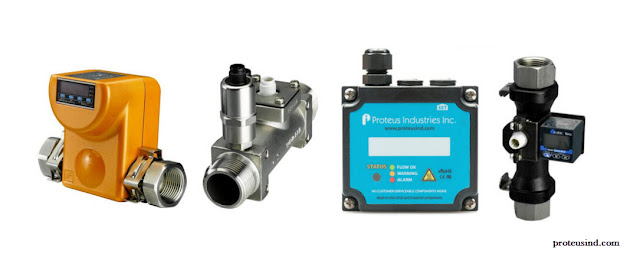Accurate Liquid Velocity Measurement Meters: Proteus Industries Inc.
Liquid velocity flow meters are used
when it becomes necessary to calculate the volumetric flow rate of a stream. A
velocity flow meter calculates flow by computing the speed in one or several
points in the flow and assimilating the flow speed over the total flow area.
Velocity flow meters are commonly
used in industries because they provide a nonstop measurement of fluid
velocity; a trait commonly associated with flow rate. This type of flow meter
is one of the most sensitive to processing conditions.
Liquid velocity measurement meters
function under the theory that there is a constant velocity profile. As a
result, they are erroneous in the laminar regime. Inaccuracy occurs due to the
large difference between fluid velocity at the center of the pipe and near the
wall. As a result, velocity flow meters are very sensitive to Reynolds numbers
and piping geometry.
Examples of liquid velocity
measurement meters include turbine, paddlewheel, electromagnetic and vortex
shedding flow meters. The following is a brief discussion of each type:
Turbine
and Paddlewheel
These two types of flow meters are
the most versatile. When a fluid flows across a turbine meter, the vanned rotor
begins to rotate. A similar action occurs with the paddlewheel type except that
its blades are perpendicular to the flow direction. In both types of flow meters,
the angular velocity of the rotor is proportionate to the fluid’s velocity.
Examples
of Use
Paddlewheel and turbine meters are
used in similar applications. A petroleum pipeline may use an insertion turbine
flow meter to detect leaks. A petroleum plant may also use turbine meters to
load light hydrocarbon products into rail cars and road tankers. Apart from
metering water, fuel and chemicals, both types of flow meters are used in
metering cryogenic gases and oil drilling processes.
Electromagnetic
Often called mag meters, these are
used to measure conductive fluids. Electromagnetic flow meters operate on
Faraday’s Law. When the conductor moves to the right angle of the magnetic
field, a voltage difference is provoked in the conductor. This difference is
proportional to the velocity of the conductor.
There are two types of
electromagnetic flow meters: insertion style and wafer style. Both rely on
different methodologies for creating a magnetic field through which conductive
fluids flow.
Examples
of Use
Electromagnetic flow meters are used
in several industries including pharmaceutical, food, beverage, cosmetic and
chemical industries. Mag meters may be used to measure the flow of cream and
milk. Specially designed mag meters are used to measure flow in an open
channel. Mag meters may be inserted into a stream or manhole to monitor the
flow rate.
Vortex
Shedding
This type of liquid velocity flow meter relies on
turbulence to measure flow rate. When the fluid flows across a non-streamlined
object, it creates turbulences on the sides of the object. These are called
vortices or eddies. As these vortices move downstream, they shed or separate
from the object and grow in size. The vortices shed from each side of the
non-streamlined object and swirl off in opposing directions. The size of the
vortices and rate of shredding is proportionate to the flow rate of the liquid.
This phenomenon is similar to what makes a flag flap in windy conditions.
Examples
of Use
Vortex flow meters are often used to
handle contaminated materials. They are frequently used to monitor liquid, gas
and steam flows in turbulent conditions. Petrochemical and chemical industries
frequently rely on vortex meters.
Contact Proteus Industries Inc.
today to learn more about liquid velocity measurement meters and how they can improve flow measurement accuracy in your
business.




Comments
Post a Comment